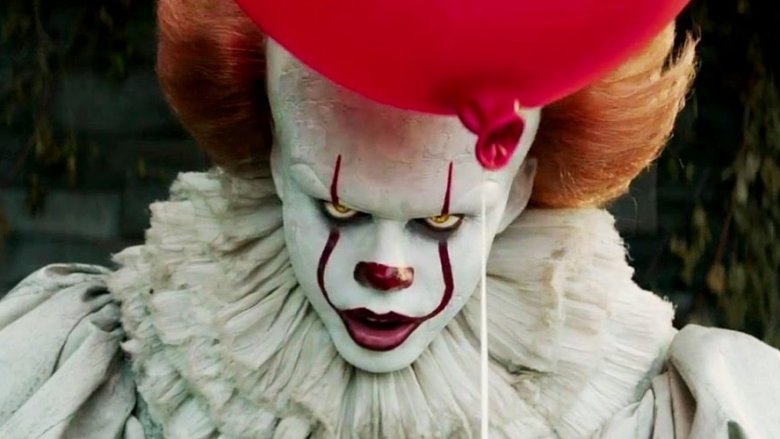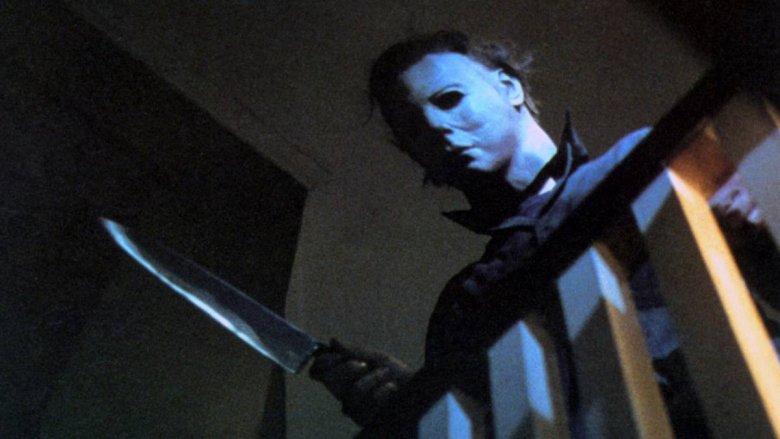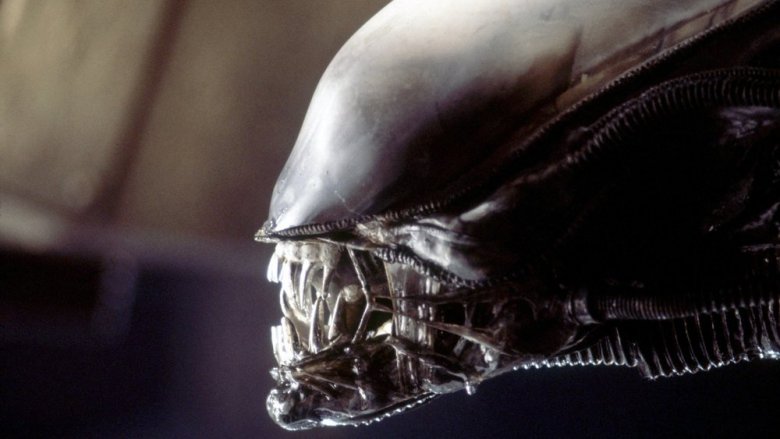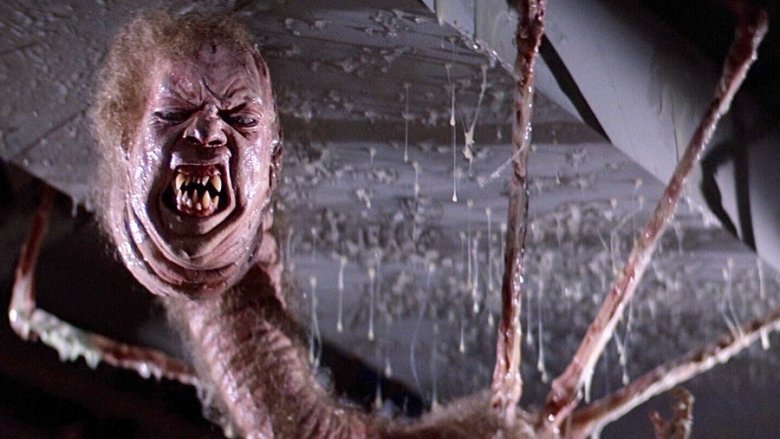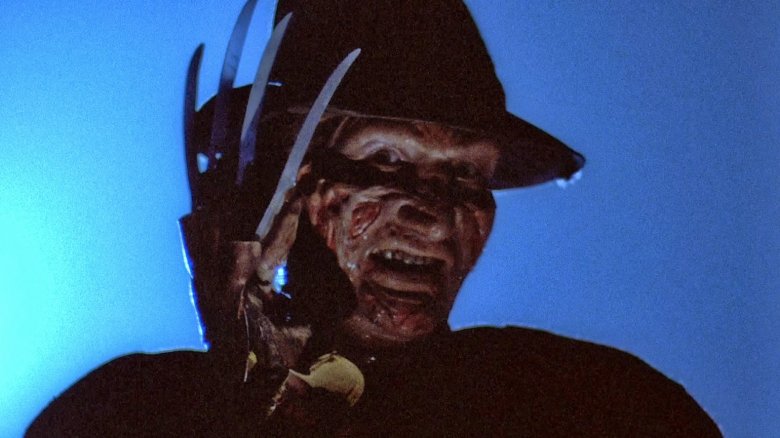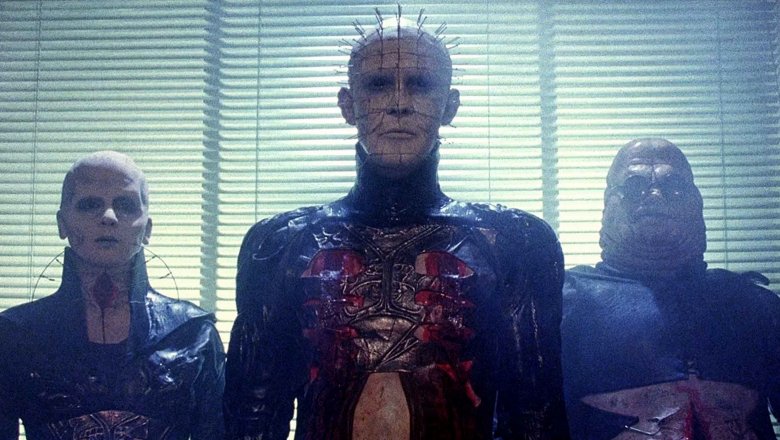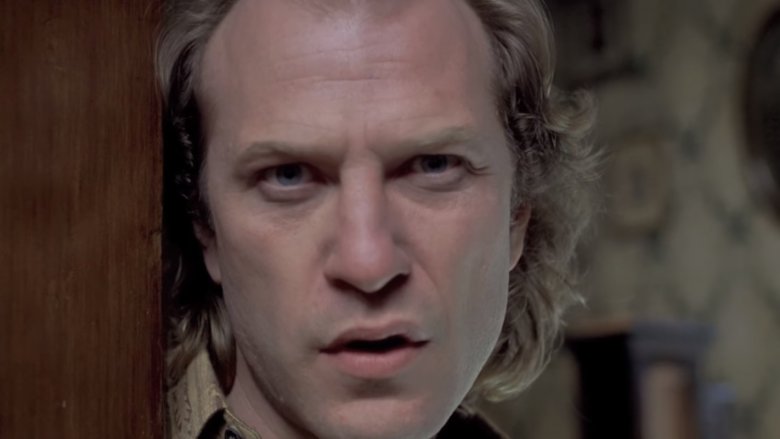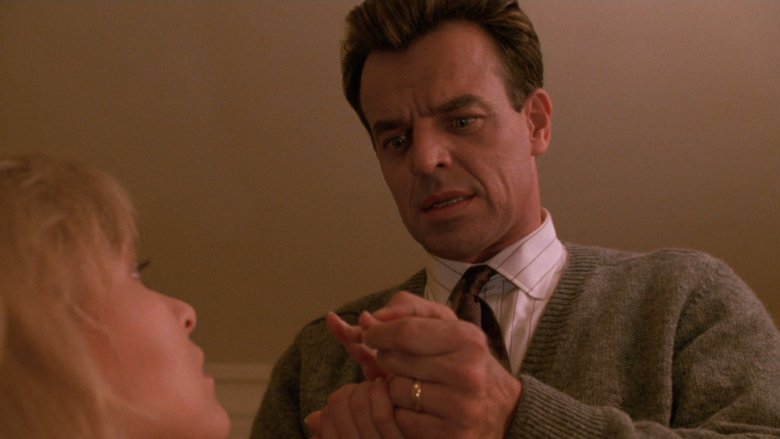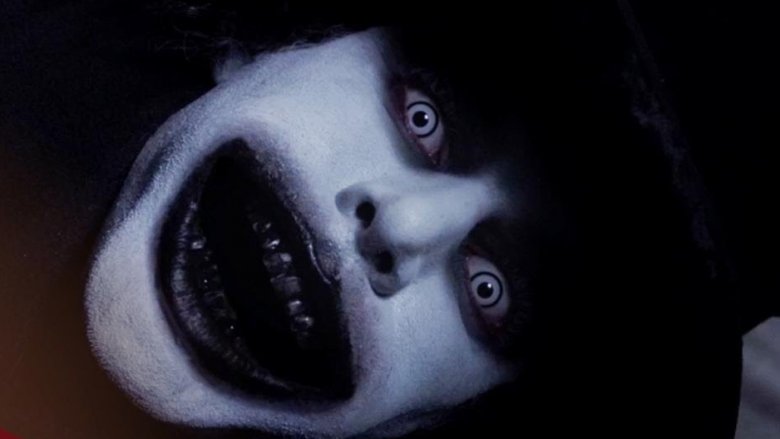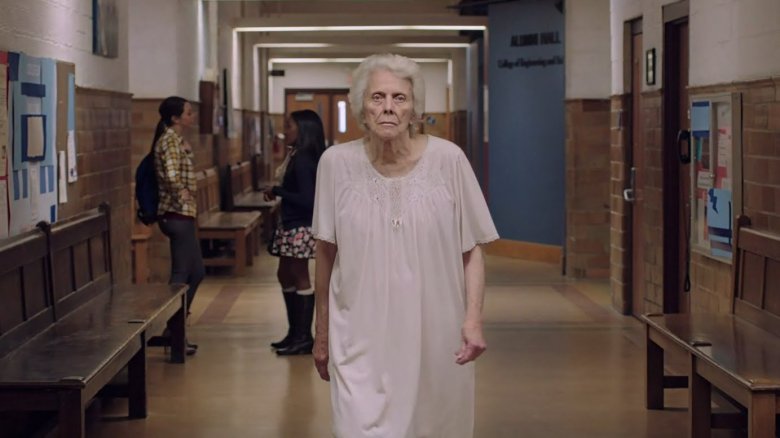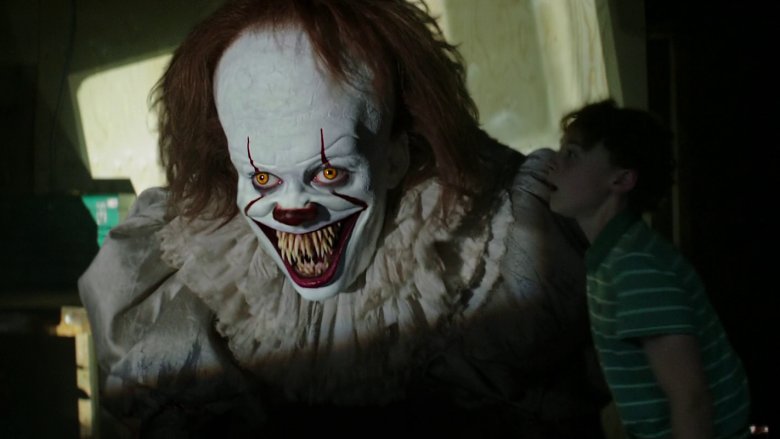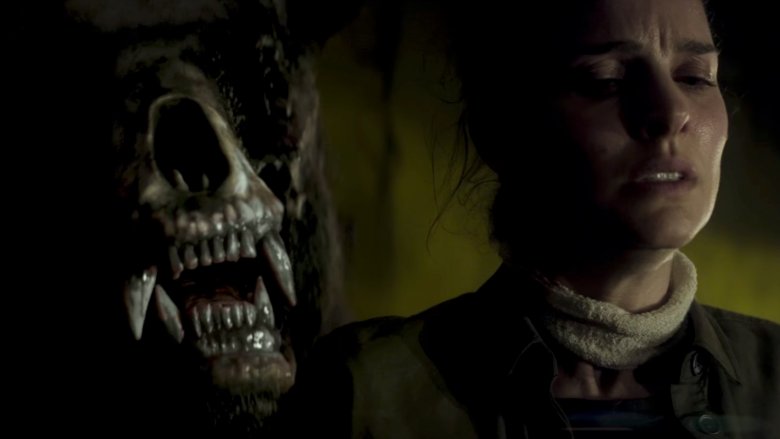The Most Terrifying Horror Movie Villains Of All Time
From Annabelle to the Living Dead zombies, the horror genre is overflowing with ghosts and ghouls, and while we forget most of these monsters, some stick with us long after the credits roll. If you look over your shoulder as you step outside or check your closet to make sure it's empty, then you know you've just watched an extra special bad guy. But what makes them stand out from the pack?
Sure, they're creepy and can kill you in creative ways, but the truly memorable villains haunt us because they're more than just monsters. They remind us we're mortal; that there are forces in the world that mean us harm. They play on our worst fears and make us question the things we hold most dear. They represent death, fear, sickness, and sin. And if you're worried there might be a beast behind you when the credits roll, then you might've encountered one of the most terrifying horror movie villains of all time.
The Boogie Man is going to get you
Michael Myers first attacked the sleepy town of Haddonfield, Illinois in 1978 — and four decades later, he's still stalking terrified teens. He's faced his fair share of reboots and retcons, but despite all the changes, Myers remains pretty much the same. He's got the gray jumpsuit, the William Shatner mask, and the motivation to keep on moving, no matter how many times you shoot him.
Myers first appeared in John Carpenter's classic Halloween, credited simply as "The Shape." And that's because Michael isn't a person. He's the boogie man, complete with a butcher's knife and the devil's eyes. He prowls through suburban neighborhoods like some sort of shark, constantly searching for his next victim. And what makes him truly terrifying — in the original, at least — is that there's no method to his madness. Michael kills people because that's what Michael does, and there's no logic to it. He's random violence personified.
Worse still, no matter how hard you try, you can't stop this guy. Stab him in the neck, put a knife in his gut, or fill him full of lead, it doesn't matter. Michael is going to get back up and keep on killing. You can't stop the boogie man. You can't kill evil with a gun. All you can do is run, scream, and hope that the man in the mask doesn't catch you.
A perfect (and pervy) killing machine
Cinema is crawling with evil extraterrestrials, from body snatchers to flesh-hungry blobs. But when it comes to creatures that inspire pure, primal horror, it doesn't get any freakier than this. Designed by H.R. Giger, the Xenomorph has haunted space truckers and colonial marines since boarding the Nostromo in 1979's Alien. And unfortunately for its victims, it wants more than to simply kill you — so much more.
After starting off as a leathery egg, the Xenomorph turns into a parasitic facehugger, explodes out of your body as a blood-drenched chestburster, and finally evolves into a killing machine that's "unclouded by conscience, remorse, or delusions of morality." From its phallic head to its dripping maw, the creature looks like a reproductive organ come to life — one that wants to turn you into an incubator for more baby Xenomorphs.
If the Xenomorph were simply a mindless animal, this nightmare life cycle might be little less horrific, but there's something sadistic about it — it seems to enjoy chasing its prey, watching them scream, and doing really pervy things to them (poor Lambert). More than just a murderer, the Xenomorph is all about violating the human body. It's a creature that really gets under our skin precisely because that's the last place we want it to be.
Someone ain't who he appears to be
Fighting a Lovecraftian creature can get pretty creepy, but you can face any baddie with your buddies by your side. But what if you're constantly checking your friends to make sure they're not morphing into monsters? Suddenly, dealing with that otherworldly demon got a lot more complicated, and that's why every scene in The Thing is dripping with dread.
Directed by John Carpenter, this 1982 horror classic finds a group of snowbound men battling a slimy shapeshifter that can impersonate anything or anyone. The titular Thing can look exactly like your coworker — until it gets you cornered, and then the tentacles come out. That's what makes this alien so frightening: When the Thing is on the loose, you can't even trust your own senses. Sure, that guy standing next to you might look and sound like Wilford Brimley, but he still could bite your head off.
That's when paranoia sets in. Suddenly, friends start turning on friends, all while the actual monster is dragging victims offscreen. When you're going against the Thing, you can't trust anybody, not even yourself. In the film's most horrific twist, the heroes don't even know if they've been infected, so they're worried they might rip apart at any moment. Maybe they're human, maybe they're not, and that awful ambiguity is what makes the Thing so frightening.
One, two, Freddy's coming for you
The scariest thing in the world is losing control. And really, that's what we do whenever we go to sleep. After crawling into bed, we slip into unconsciousness, where — for most people — the mind goes wild. You might find yourself trapped in a horrifying nightmare, but at least you're going to wake up unharmed. After all, it's just a dream... unless you're sharing that dream with Freddy Krueger.
The sweater-wearing villain from the Nightmare on Elm Street franchise, Freddy enjoys taunting teenagers before finishing them off, usually in brutally inventive ways. Of course, there are plenty of slashers with a dramatic flair, but what really sets Freddy apart from the pack is the way he invades your mind and completely takes control.
Freddy is basically the god of nightmares. The law of physics don't apply in the dreamworld, so Freddy can create any scenario he wants. Theoretically, your bedroom should be the safest place in your home, and when you close your eyes at night, you fully expect to wake up the next morning. But when Freddy Krueger is lurking in the shadows of your subconscious, there's no guarantee you'll live to see the sunrise.
They'll tear your soul apart
If Michael Myers or the Xenomorph gets you, it's going to hurt, but once you're dead, that's pretty much the end of it. Unfortunately, that's not how it works with the Cenobites. If you open up that dreadful little puzzle box and summon these BDSM demons, you'll spend the rest of eternity howling in torment.
Created by Clive Barker, the Cenobites made their first cinematic appearance in 1987's Hellraiser, terrifying audiences with their fetishistic fashion. While there are plenty of horror villains with their own unique look, there's something especially unsettling about Pinhead and his merry band. Each Cenobite comes with its own bizarre deformity, like the Chatterer's peeled lips, Butterball's swollen face, and the Female's gaping throat.
But self-mutilation aside, the Cenobites are especially frightening because when they get you, they get you forever. These guys consider themselves "explorers in the further regions of experience," but they've gone so far in their hedonistic quest that pleasure and pain are the same things to them. Still, the Cenobites live by a simple code — solve the Lament Configuration, and you're coming with them to Hell so they can get to know your flesh. And spoiler alert, tasting their pleasures isn't very pleasurable.
They call him Buffalo Bill
The Silence of the Lambs features one of the greatest serial killers in cinematic history: Hannibal Lecter. But while he's a villain for the ages, there's something kind of charming about the guy. You can't help but admire Hannibal because he's witty, refined, and absolutely electric.
Jame Gumb is none of those things.
Played by Ted Levine, there's nothing endearing about Gumb. He's slimy and sleazy, a genuine monster with an animal cunning when it comes to hunting women. As pointed out by Rolling Stone, Gumb is likely an amalgam of three real-life murderers: Ted Bundy (who used the cast trick), Ed Gein (who skinned corpses to make a "woman suit"), and Gary Heidnik (who kept victims in a pit).
So whenever he shimmies onto the screen, our skin crawls because we know he wants it so bad for his sewing machine. Whatever your opinion on nature vs. nurture, something broke inside of Gumb a long time ago. Occasionally, a bit of empathy creeps back into his reptile brain, but for the most part, he sees his victims as sacks of meat that need to be skinned. While it's freaky to imagine yourself at the mercy of Freddy Krueger or the Cenobites, picturing yourself in Gumb's dungeon is far, far worse...because you could actually find yourself down there one day.
Fire walk with me
Who killed Laura Palmer? For better or worse, Twin Peaks fans got their answer in season two of the seminal TV show, when it was revealed the homecoming queen (Sheryl Lee) was murdered by her own father, Leland Palmer (Ray Wise).
Well, sort of.
As Special Agent Dale Cooper (Kyle MacLachlan) explained, Leland wasn't to blame for raping and killing his daughter. The real villain was BOB (Frank Silva), a demon from the Black Lodge who possessed Leland. But the incest issue gets a little bit trickier (and a whole lot ickier) in Twin Peaks Fire Walk With Me, a movie that shows the last days of Laura Palmer and the Palmer family dynamics at play.
Leland is eerily possessive of his daughter, has no problem gaslighting her, and when he's not harassing Laura, he's visiting (and killing) prostitutes. Grosser still, the way he secretly watches Laura and grabs her hands and won't let go — causing her to cower in fear — implies that Leland might actually be okay teaming up with BOB.
A kid is supposed to feel safe in her own home, and parents are supposed to take care of their children. But poor Laura, confused and abused, can't even trust her own dad, a man who leers at her from across the room and who drugs her mother at night so she won't hear Laura's screams.
You can't get rid of the Babadook
If it's in a word, or if it's in a look, you can't ever really get rid of grief. It lays waste to your soul and buries deep in your bones. And if you let it simmer, it might turn into a top hat-wearing demon.
The Babadook is so much more than your run-of-the-mill monster. With its ghoulish grin and menacing fingers, it's the embodiment of bereavement, anguish, and anger that's been pushed down so long that it's about to explode. And Amelia (Essie Davis) certainly has a lot to grieve. She lost her husband during a fatal car crash — as he was rushing his pregnant wife to the hospital — and now she's trapped with a child (Noah Wiseman) who builds dangerous weapons, assaults other kids, and suffocates her every day, both metaphorically and literally. He's a living reminder of what happened, and every day, she's haunted by her husband's memory. So when the Babadook comes along, Amelia finds herself faced with the horrible option of either trying to move on or giving herself over to the demon and killing the kid she blames for everything.
But even after battling the beast, Amelia finds you can never truly get rid of your grief. You might learn to deal with it, but you're never going to forget. The grief will always linger, hiding in the corners of your basement. And if you don't remain vigilant, the Babadook might come back.
No matter where you run, it just keeps following
Despite all its blood and gore, the horror genre is pretty puritanical when it comes to sex. If a slasher catches you getting it on, you're going to meet the sharp edge of a machete. Filmmaker David Robert Mitchell wanted to subvert that old trope, so he wrote and directed It Follows, an atmospheric horror film about a girl with the world's worst STD.
After sleeping with her new boyfriend for the first time, Jay Height (Maika Monroe) learns that she got a lot more than a sexy date. She's just received a curse, in the form of a shapeshifting creature that only she can see. The nameless "It" will follow her for the rest of her life, ambling behind her until it catches up. The only way Jay can get rid of It is by having sex with someone else and passing on the curse.
It never speaks a word and never break into a sprint. It just keeps on coming, one step at a time, and It doesn't stop. It might look like a giant, an old woman, or your long-lost dad — whatever it takes to get close. Really, It is a whole lot like death, slowly but surely creeping your direction. Even if you think you've beaten the curse, you never know when It might show up again, coming up behind you when you least expect it.
We all float down here
Most great horror villains have some sort of origin story. Freddy Krueger was a child murderer burned by vengeful parents. Pinhead was a British World War I soldier transformed into a Cenobite. But the titular "It" from Andy Muschietti's blockbuster has no origin. It is a dark and evil spirit, as old and mysterious as the universe. It's an entity that's always been here, manipulating the fear of its victims before devouring their flesh. It can appear as whatever you dread: a leper, a mummy, an abusive father. Often, this inter-dimensional demon takes the form of Pennywise the Dancing Clown (Bill Skarsgard), a creature whose cruelty never ages and whose evil never dies.
Pennywise has plagued Derry, Maine, for centuries, and has a taste for young children. The town is completely plastered with "Missing Child" posters. In fact, Pennywise's evil influence can be felt all over Derry, as adults are eager to turn a blind eye to the horrors happening in their streets. Since it's easier to just ignore evil, they give Pennywise a pass as he stalks their children. Making things worse, Pennywise enjoys what he's doing. The more afraid you are, the better he likes it. And even if you band together with all your friends to drive him off, the Derry demon will just slink away into the sewers and wait for round two, because no matter how hard you try, evil will always return.
A vengeful god looking for justice
What if there's a god, and what if he hates you? Whether or not you believe in a supreme being, it's unsettling to think of an omnipotent force that's actively trying to destroy you. After all, God is supposed to be loving, but Martin Lang is anything but benevolent.
Played to unsettling perfection by Barry Keoghan, Martin is the teenage villain in The Killing of a Sacred Deer, an eerie film about a man in the crosshairs of a angry deity. Granted, Stephen Murphy (Colin Farrell) isn't exactly a great guy. He's an alcoholic surgeon who negligently killed Martin's dad on the operating table. Even worse, he absolutely refuses to take any blame for his mistakes or acknowledge any wrongdoing.
So Martin decides to use his inexplicable powers to deliver some Old Testament (or, perhaps, Greek) justice, smiting Steven's family with a plague that involves paralysis, starvation, and eventually, death. The only way Steven can save his family is by killing one of them to placate Martin. And unless Steven does the deed, his family is going to slowly and painfully waste away.
What's truly upsetting is how matter-of-fact Martin is about the whole affair. He's not cackling or grinning. He doesn't view himself as evil. He's looking for vengeance, no matter how sadistic it might seem, and he won't stop until Steven makes the sacrifice. You can beg, you can scream, and you can pray all you want, but Martin won't be moved until you finally pull the trigger.
Making something new...and horrific
Nature is supposed to behave certain ways. Sharks can't breed with alligators. Deer don't suddenly sprout doppelgängers. And human intestines aren't supposed to slither around like anacondas. But the laws governing the universe don't apply in Alex Garland's Annihilation, specifically inside the Shimmer, a mysterious electromagnetic field that's growing across the Southern US. The Shimmer first appeared after a mysterious object hurtled through space and crashed into a lighthouse, and as its boundaries expand, the Shimmer creates new lifeforms, mixing and mashing the DNA of creatures that pass through its otherworldly walls.
Working like a gene splicer, the Shimmer occasionally creates some beautiful crossbreeds. But often, it ends up making a beast like the skull bear. A hideous, sickly monster, the skull bear's body is covered in fur, but when you see its face, things get freaky. Instead of hair, it's just exposed bone...plus a human skull melded to the side of its head. Worse still, this horrific creature can imitate the sounds of its victims, so when it hunts a group of scientists, the bear screams out the final words of their ill-fated friend. Hearing a bear scream like a woman is the ultimate nightmare fuel, especially since it's hoping you'll panic. The moment you react, that's when the bear pounces. Dealing with a powerful predator is bad enough, but running from a creature that's been perverted by nature? That's simply unbearable.
